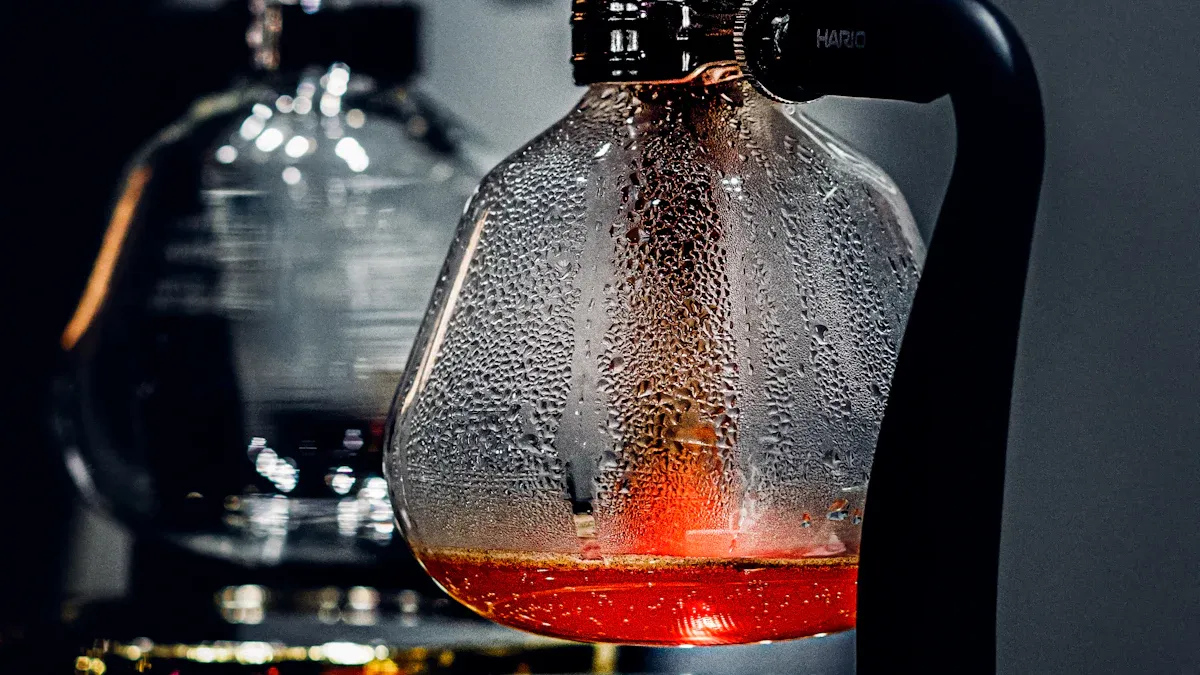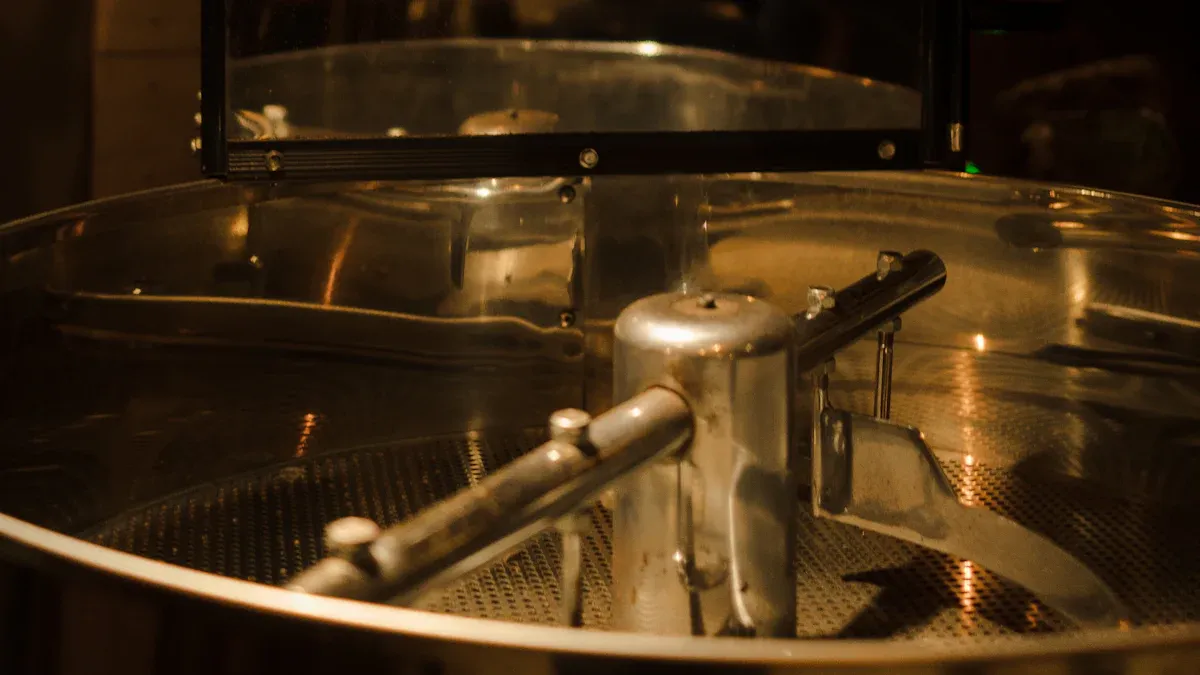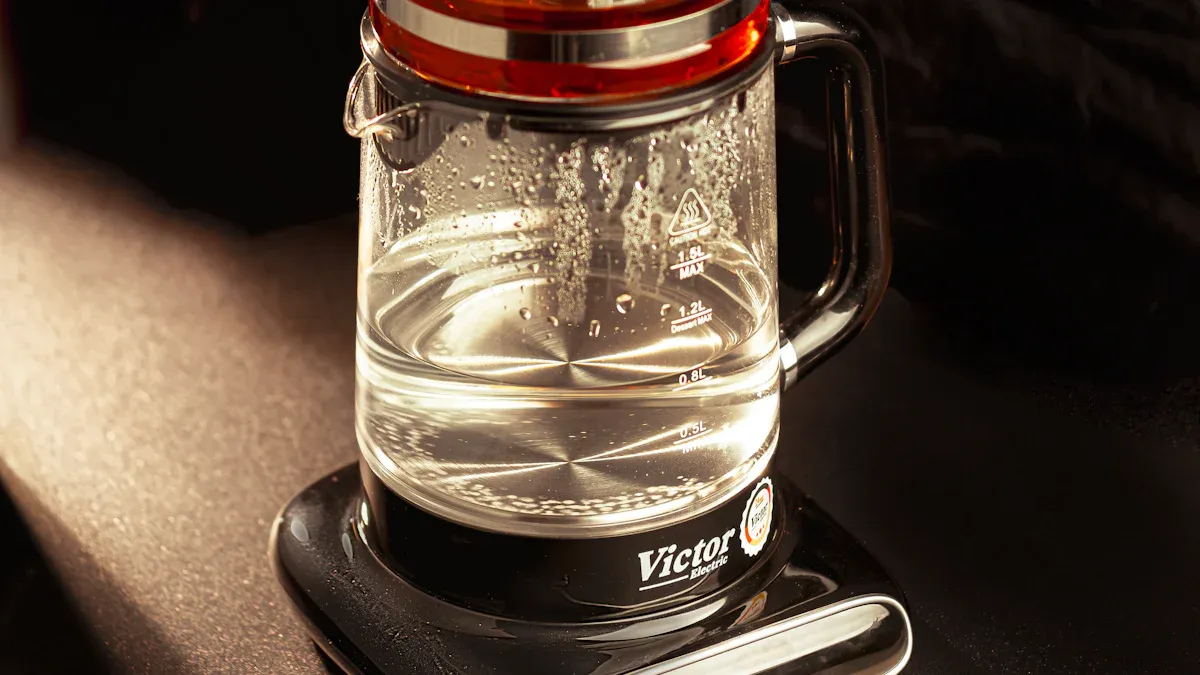
A coffee machine heating element has a few main parts:
Heating coil
Thermostat
Thermal fuse
Aislamiento
Housing
Connectors
Every part in coffee machine heating elements is important. The heating coil makes the water hot. The thermostat controls how hot it gets. The thermal fuse keeps the machine safe. Insulation holds the heat inside. Housing and connectors let all the parts work together to make coffee.
Principales conclusiones
The heating coil heats water fast and spreads heat well. This helps the coffee taste better. The thermostat keeps the water at the right temperature. This makes the coffee the same every time and saves power. The thermal fuse stops the machine from getting too hot. It keeps the machine safe and stops it from breaking. Insulation holds the heat inside the machine. It also makes the outside safer to touch. Good connectors and housing keep all the parts together. They also make fixing the machine safe and simple.
Coffee Machine Heating Elements: Main Parts

Heating Coil
The heating coil is what makes the water hot. Most coils are made from metal like stainless steel. Stainless steel can handle very high heat. Some coils have a stainless steel tube inside aluminum. Aluminum helps spread the heat around the coil. This makes the heat go everywhere more evenly. It helps the machine work better and faster.
Stainless steel coils are strong and last long.
Aluminum tubes help move heat better.
The coil is inside the machine and fits the water path.
When heat spreads well, water gets hot fast and evenly. This helps make coffee taste better.
Thermostat
The thermostat checks the temperature in the heating element. It turns the heating coil on or off. This keeps the water at the best temperature for coffee. If the water gets too hot, the thermostat turns the coil off. If the water cools down, it turns the coil back on.
Thermostats help save power.
They stop the water from boiling over.
They keep the coffee tasting the same every time.
Thermal Fuse
El thermal fuse is a safety part in the heating element. It stops the machine from getting too hot. If the temperature goes too high, the fuse breaks the circuit. This stops the coil from working and keeps things safe. When the fuse works, the machine may stop heating or show an error. This keeps the machine safe from harm.
Thermal fuses are also called safety thermostats. They stop the machine from overheating. If something goes wrong, the fuse stops the heat. Many new machines show an error or stop working. This shows how important the fuse is for safety.
Aislamiento
Insulation wraps around the coil and hot parts. It keeps the heat inside the machine. Good insulation helps save energy. It also keeps the outside cooler and safer to touch.
Insulation is made from materials that resist heat.
It helps keep water at the right heat.
It keeps other parts from getting too hot.
Housing
The housing holds all the heating element parts together. It covers the coil, thermostat, fuse, and insulation. The housing is made from metal or strong plastic. It keeps the inside parts safe from dust and water.
Housing gives the heating element its shape.
It keeps all the parts in place.
It covers hot parts to help with safety.
Connectors
Connectors join the heating element to the coffee machine. They bring electricity to the coil and other parts. Some connectors screw in, and some slide on and off. These connectors make it easy to put in or take out the heating element.
Threaded connectors screw in tightly.
Spade connectors slide on and off easily.
Good connectors keep the electricity flowing safely.
Every part in the heating element has a job. The coil heats the water. The thermostat and fuse keep it safe. Insulation keeps heat in. The housing protects the parts. Connectors link everything together.
Functions of Each Part
Heating Water
The heating coil is in the middle of the heating element. It uses electricity to make heat. Water moves around the coil and gets hot fast. The metal on the coil spreads the heat everywhere. This helps water get hot enough for coffee. When the coil works right, you get hot coffee quickly.
Tip: If you keep the coil clean, water heats up faster and coffee tastes better.
Control de temperatura
The thermostat checks how hot the water is. If water gets too hot, it turns off the coil. When water cools down, it turns the coil back on. This keeps the water at the best heat for coffee. The thermostat helps every cup taste the same.
Parte | Función |
|---|---|
Thermostat | Controls water temperature |
Heating Coil | Raises water temperature |
Características de seguridad
The thermal fuse is a safety part. If the coil gets too hot, the fuse stops the power. This keeps the coil from working. The fuse keeps the machine safe and stops damage. Insulation also helps with safety. It keeps heat inside and stops the outside from getting too hot.
Thermal fuse: Stops overheating
Insulation: Keeps heat in and protects users
Electrical Connections
Connectors join the heating element to the rest of the machine. They bring power to the coil and other parts. Good connectors help the machine work safely. They also make fixing or changing parts easy. Housing holds all the parts together and keeps them safe from dust and water.
Note: Tight connectors help stop electrical problems in coffee machine heating elements.
Materials Used

Rieles
Coffee machine heating elements need strong metals. These metals must handle heat and water. Stainless steel is used a lot. It does not rust and stays strong when hot. Some heating elements use copper-nickel alloys. These metals move heat fast and last long. Incoloy and special alloys like AL-6XN® or Hastelloy® are in fancy machines. These metals work well in hard places and keep the heating element steady.
Propiedad | Stainless Steel (304, 316, 403) | Copper-Nickel Alloys (70/30, 90/10) |
|---|---|---|
Resistencia a la corrosión | High; forms passive oxide layer | Excellent; forms protective oxide layer |
Mechanical Strength | High tensile strength, good hardness | Good ductility, enhanced with alloys |
Conductividad térmica | Moderate (8.1–15.1 Btu/(ft·hr·°F)) | Higher (29–40 W/m·K) |
Application Suitability | Food, marine, industrial | Marine, heat exchangers |
Stainless steel and copper-nickel alloys both last long. They work well in heating elements.
Insulation Types
Insulation keeps heat inside the heating element. Makers use mica, fiberglass, or ceramic. Mica sheets do not burn and stop heat from escaping. Fiberglass wraps around coils and blocks heat loss. Ceramic insulation can take very high heat and keeps the outside cool. These materials save energy and protect people from burns.
Mica: Thin sheets that resist heat
Fiberglass: Strong and bends easily
Ceramic: Hard and stands up to heat
Sheath Materials
A sheath covers the heating coil and keeps it safe. Stainless steel sheaths are common and do not rust. Some machines use copper or Incoloy sheaths for more safety. These sheaths stop water and chemicals from hurting the coil. A good sheath keeps the heating element working well.
Cleaning and checking the sheath often helps it last longer and keeps the coffee machine safe.
Installation and Testing
Power Ratings
Coffee machine heating elements have different power levels. Most home machines use 600 to 1400 watts. Bigger machines in stores use more power for faster heating. The voltage depends on the country. In the United States, it is 110-120V. In Europe, it is 220-240V. The right power helps heat water fast and keeps it hot. When putting in a new heating element, check the manual for the right wattage and voltage. Using the wrong power can make heating slow or break the machine.
Tip: Always look at the label on the heating element before you put it in. Make sure it matches what your machine needs.
Replacement
Heating elements can stop working after a while. If your coffee heats slowly, not at all, or the safety fuse trips, it may be broken. When you get a new heating element, pick one with the same power and connector type. Many machines use threaded or spade connectors. These make it easy to take out and put in parts. Safety marks like UL, CE, NSF, and CSA mean the part is safe. These marks show the part passed tests for safety, strength, and good materials.
UL, CE, NSF, and CSA marks show the part is safe.
Certified parts help stop overheating and electrical problems.
Makers give manuals to help you install parts safely.
Testing Methods
Testing the heating element helps find problems early. Technicians use a multimeter to check if electricity flows through the coil. If there is no flow, the coil may need to be changed. Some people use a Scace Thermofilter Temperature Device for more testing. This tool checks water temperature at the brewing spot. It uses a Type T thermocouple, which is very accurate near boiling. The device fits in a portafilter and checks temperature during real brewing.
Aspecto | Detalles |
|---|---|
Measurement Tool | Scace Thermofilter Temperature Device |
Sensor Type | Type T thermocouple (very accurate near boiling) |
Solicitud | Measures brewing water temperature for setup, tuning, and diagnostics |
Safety Note | Handle with care; hot water can cause burns |
Note: Using certified heating elements and testing them the right way keeps coffee machines safe and working well.
Coffee machine heating elements have many key parts. Each part does something important. The heating coil makes the water hot. The thermostat keeps the heat just right. The thermal fuse helps keep things safe. Insulation keeps the heat from escaping. The housing and connectors hold all the parts together. All these parts work together to make coffee safely and well. Taking care of your machine helps it last longer and work better.
Knowing about coffee machine heating elements helps people take care of their machines.
PREGUNTAS FRECUENTES
What does a coffee machine heating element do?
A coffee machine heating element makes water hot for brewing. It uses electricity to heat the water for coffee. The element helps the machine work fast. It also keeps the coffee at the right heat.
What happens if the heating element fails?
If the heating element stops working, water will not get hot. The coffee may come out cold or not brew at all. Some machines show an error or stop for safety reasons.
What materials make up a heating element?
Most heating elements are made from stainless steel, copper-nickel alloys, or Incoloy. These metals do not rust and can take high heat. Insulation like mica, fiberglass, or ceramic keeps heat inside.
What signs show a heating element needs replacement?
If the machine heats slowly, has no hot water, or the safety fuse trips often, the heating element may need to be replaced. A technician can use a multimeter to find problems.
What safety features protect coffee machines from overheating?
Coffee machines have a thermal fuse and thermostat for safety. The thermal fuse cuts power if the machine gets too hot. The thermostat keeps the water from getting too hot.


